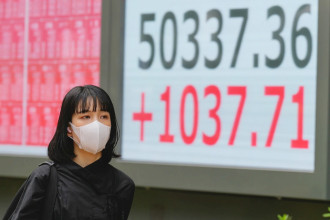
WASHINGTON: The more President Donald Trump discusses his efforts to secure deals with America’s trading partners, the more confusing the tariff landscape becomes. His team appears comfortable with this ambiguity, describing it as “strategic uncertainty” used to his advantage.
Trump has stated that the United States does not need to sign any agreements, claiming it could finalise 25 deals immediately. He insists he is seeking fair agreements across the board and is unconcerned with other nations’ markets. He also says his team is prepared to negotiate but could instead impose a set of tariffs unilaterally.
“I am struggling to make sense of it,” Chad Bown, a senior fellow at the Peterson Institute for International Economics, wrote in an email.
Late on Wednesday, Trump posted on his social media site that he would be holding a press conference on Thursday morning regarding a “MAJOR TRADE DEAL WITH REPRESENTATIVES OF A BIG, AND HIGHLY RESPECTED, COUNTRY.” He added that it would be “THE FIRST OF MANY!!!”
While Trump’s team cites his best-selling book *The Art of the Deal* as evidence that he has a master strategy, much of the world remains on edge. This uncertainty has contributed to stock market volatility, hiring freezes, and general economic unease, even as Trump continues to promise new factories and job creation.
Trump still wants tariffs
As part of any deal, Trump seeks to retain certain tariffs, arguing that import taxes could generate substantial revenue for the heavily indebted federal government, despite other countries viewing the elimination of tariffs as the primary objective of trade agreements.
“They’re a beautiful thing for us,” Trump recently said about tariffs. “If you can use them, if you can get away with using them, it’s going to make us very rich. And we’ll be paying off debt, we’ll be lowering your taxes very substantially because so much money will be taken in that we’ll be able to lower your taxes even beyond the tax cut that you’re going to be getting.”
So far this year, the US government has collected $45.9 billion from tariffs, approximately $14.5 billion more than last year, according to the Bipartisan Policy Center. Those revenues could increase significantly given the 10% baseline tariffs, the 145% rate imposed on Chinese goods, and duties of up to 25% on steel, aluminium, automobiles, and Mexican and Canadian imports.
To achieve Trump’s stated goals of repaying the $36 trillion debt and reducing income taxes, his tariffs would need to raise at least $2 trillion annually without triggering an economic downturn that could reduce overall tax revenues—a scenario that appears mathematically implausible.
How do negotiations work?
The Republican administration claims that 17 of its 18 major trading partners have essentially presented them with term sheets outlining potential compromises. However, agreeing on terms would be just the first step in trade negotiations.
Foreign leaders have expressed confusion over Trump’s precise demands and questioned how agreements could be formalised into lasting deals. They also note that although Trump approved the United States-Mexico-Canada Agreement in 2020, he later imposed new tariffs on those same trading partners.
During a meeting with Trump on Tuesday, Canadian Prime Minister Mark Carney suggested that the next iteration of the agreement would need to be strengthened to prevent arbitrary tariff impositions, such as this year’s fentanyl-related tariffs that Canada viewed as unjustified.
“Some things about it are going to have to change,” Carney stated.
Can the US reach a deal with China?
The 145% tariffs on China—and Beijing’s retaliatory 125% tariffs on US goods—loom over the entire negotiation process. Treasury Secretary Scott Bessent has acknowledged that these tariffs are “not sustainable.”
Initial talks between the US and China are scheduled to begin this weekend in Switzerland but are likely to focus on de-escalating tensions rather than substantive negotiations.
The core issue is China’s dominance in manufacturing and exports, which can undermine domestic industries in other countries. Because China prioritises production over internal consumption, global markets absorb Chinese goods due to limited domestic demand. The US seeks to rebalance trade but has also imposed tariffs on countries that could otherwise be its natural allies in defending their automotive and technology sectors against Chinese competition.
“Obviously, in this trade puzzle, China is the biggest piece,” Bessent remarked this week. “Where do we end up with China?”
Chinese Foreign Ministry spokesperson Lin Jian has suggested that a constructive approach by the Trump administration would be to soften its rhetoric and reduce punitive import taxes.
“If the US truly wants to resolve the issue through dialogue and negotiation, it should stop threatening and pressuring and engage in dialogue with China on the basis of equality, respect and mutual benefit,” Lin said on Tuesday.
When asked on Wednesday whether he would lower tariffs on China as a condition for negotiations, Trump simply responded, “No.”
The president also dismissed claims by the Chinese government that the US had initiated the Geneva talks, stating, “Well, I think they ought to go back and study their files.”
Would Congress need to approve any deals?
Not necessarily.
Trump imposed his universal tariffs unilaterally, invoking the 1977 International Emergency Economic Powers Act, which has resulted in multiple lawsuits. His administration argues that modifying tariff rates does not require congressional approval.
Historically, presidents—including Trump during his first term—could negotiate only limited trade agreements covering specific tariff or trade issues, according to an updated Congressional Research Service report. Examples of such deals include a 2023 agreement on critical minerals and a 2020 digital trade pact with Japan.
Trump has also incorporated non-tariff barriers, such as automotive safety regulations and European value-added taxes, into trade discussions. He seeks policy changes from other nations in exchange for reduced US tariffs, though other countries might oppose American subsidies to domestic businesses.
In principle, congressional approval would be necessary for a deal addressing “non-tariff barriers and requiring changes to US law,” according to the Congressional Research Service.
Is it really a deal if Trump simply imposes it?
If other nations fail to meet his expectations, Trump has indicated he may unilaterally set tariff rates, as he did with his 2 April “Liberation Day” tariffs. Those import taxes triggered a financial market sell-off, prompting him to delay some tariffs for 90 days and temporarily impose a lower 10% baseline rate while negotiations proceed.
Trump may choose not to implement the originally proposed tariffs if he perceives other countries as offering sufficient concessions. This would mean the US relinquishes nothing, as the tariffs themselves are new. Conversely, he could withdraw tariffs without necessarily securing any meaningful trade benefits in return.
“Trump is notorious for making maximalist demands and then retreating as negotiations progress, so we’ll see how long he sticks with his formula,” said William Reinsch, a senior adviser at the Center for Strategic and International Studies, a Washington-based think tank. “But so far, it is pretty clear that countries approaching these talks expecting a ‘normal’ trade negotiation—where both sides make substantive concessions—are being rebuffed.”
By RSS/AP






